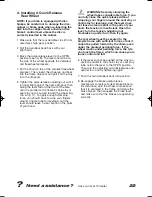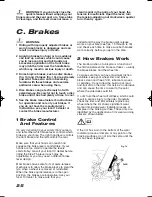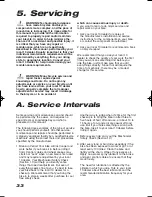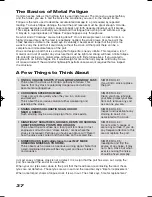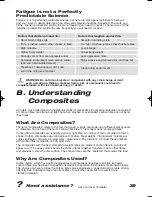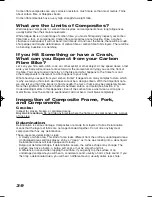
2 How An Internal
Gear Hub Drive
Train Works
If your bicycle has an internal gear hub drive
train, the gear changing mechanism will consist
of:
• a 3, 5, 7, 8, 9 or possibly 12 speed internal
gear hub
• one, or sometimes two shifters
• one or two control cables
• one front sprocket called a chainring
• a drive chain
a. Shifting Internal Gear Hub Gears
Shifting with an internal gear hub drive train is
simply a matter of moving the shifter to the
indicated position for the desired gear. After you
have moved the shifter to the gear position of
your choice, ease the pressure on the pedals for
an instant to allow the hub to complete the shift.
b. Which Gear Should I Be In?
The numerically lowest gear (1) is for the
steepest hills. The numerically largest gear (3, 5,
7, 8, 9 or 12, depending on the number of
speeds of your hub) is for the greatest speed.
Shifting from an easier, “slower” gear (like 1) to a
harder, “faster” gear (like 2 or 3) is called an
upshift. Shifting from a harder, “faster” gear to an
easier, “slower” gear is called a downshift. It is
not necessary to shift gears in sequence.
Instead, find the “starting gear” for the conditions
– a gear which is hard enough for quick
acceleration but easy enough to let you start
from a stop without wobbling – and experiment
with upshifting and downshifting to get a feel for
the different gears. At first, practice shifting
where there are no obstacles, hazards or other
traffic, until you’ve built up your confidence.
Learn to anticipate the need to shift, and shift to
a lower gear before the hill gets too steep. If you
have difficulties with shifting, the problem could
be mechanical adjustment, see your
local 13
dealer
for help.
E. Pedals
1 Toe Overlap is when your toe can touch the
front wheel when you turn the handlebars to
steer while a pedal is in the forward most
position. This is possible if you fit larger / wider
tyres or longer replacement cranks, and is
avoided by keeping the inside pedal up and the
outside pedal down when making sharp turns.
On any bicycle, this turning technique will
prevent the inside pedal from striking
the ground.
WARNING: Toe Overlap could cause
you to lose control and fall. Ask your
local 13 dealer to help you determine if the
combination of frame size, crank arm length,
pedal design and shoes you will use results
in pedal overlap.
Whether you have overlap or not, you must
keep the inside pedal up and the outside
pedal down for maximum ground clearance
when making sharp turns.
2 Some bicycles come equipped with pedals that
have sharp and potentially dangerous
surfaces. These surfaces are designed to add
safety by increasing grip between the rider’s
shoe and the pedal. If your bicycle has this
type of high-performance pedal, you must take
extra care to avoid serious injury from the
pedals’
sharp surfaces. Based on your riding
style or skill level, you may prefer a less
aggressive pedal design, or chose to ride with
shin pads. Your
local 13 dealer
can
show you
a number of options and make
suitable
recommendations.
3 Toeclips and straps are a means to keep feet
correctly positioned and engaged with the
pedals. The toeclip positions the ball of the foot
over the pedal spindle, which gives maximum
pedaling power. The toe strap, when tightened,
keeps the foot engaged throughout the rotation
cycle of the pedal. While toeclips and straps
give some benefit with any kind of shoe, they
work most effectively with cycling shoes
designed for use with toeclips. Your
local 13
dealer
can explain how toeclips and
straps
work. Shoes with deep treaded soles or
welts,
which might make it more difficult for you
to
remove your foot, should not be used with
toeclips and straps.
29
13
owners manual GENERIC A5 aw
05/05/14
10:25 Page 31








